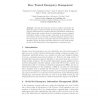Free Online Productivity Tools
i2Speak
i2Symbol
i2OCR
iTex2Img
iWeb2Print
iWeb2Shot
i2Type
iPdf2Split
iPdf2Merge
i2Bopomofo
i2Arabic
i2Style
i2Image
i2PDF
iLatex2Rtf
Sci2ools
102
Voted
ESSOS
2009
Springer
2009
Springer
Idea: Trusted Emergency Management
Through first-responder access to sensitive information for which they have not been pre-vetted, lives and property can be saved. We describe enhancements to a trusted emergency information management (EIM) system that securely allows for extraordinary access to sensitive information during a crisis. A major component of the architecture is the end-user device, the security of which is enhanced with processorlevel encryption of memory. This paper introduces an approach to more efficiently use the processor-encryption feature for secure data storage, as well as ISA instructions for the management of emergency state.
Emergency Information Management | ESSOS 2009 | Secure Data Storage | Sensitive Information | Software Engineering |
Related Content
| Added | 19 May 2010 |
| Updated | 19 May 2010 |
| Type | Conference |
| Year | 2009 |
| Where | ESSOS |
| Authors | Timothy E. Levin, Cynthia E. Irvine, Terry Benzel, Thuy D. Nguyen, Paul C. Clark, Ganesha Bhaskara |
Comments (0)

